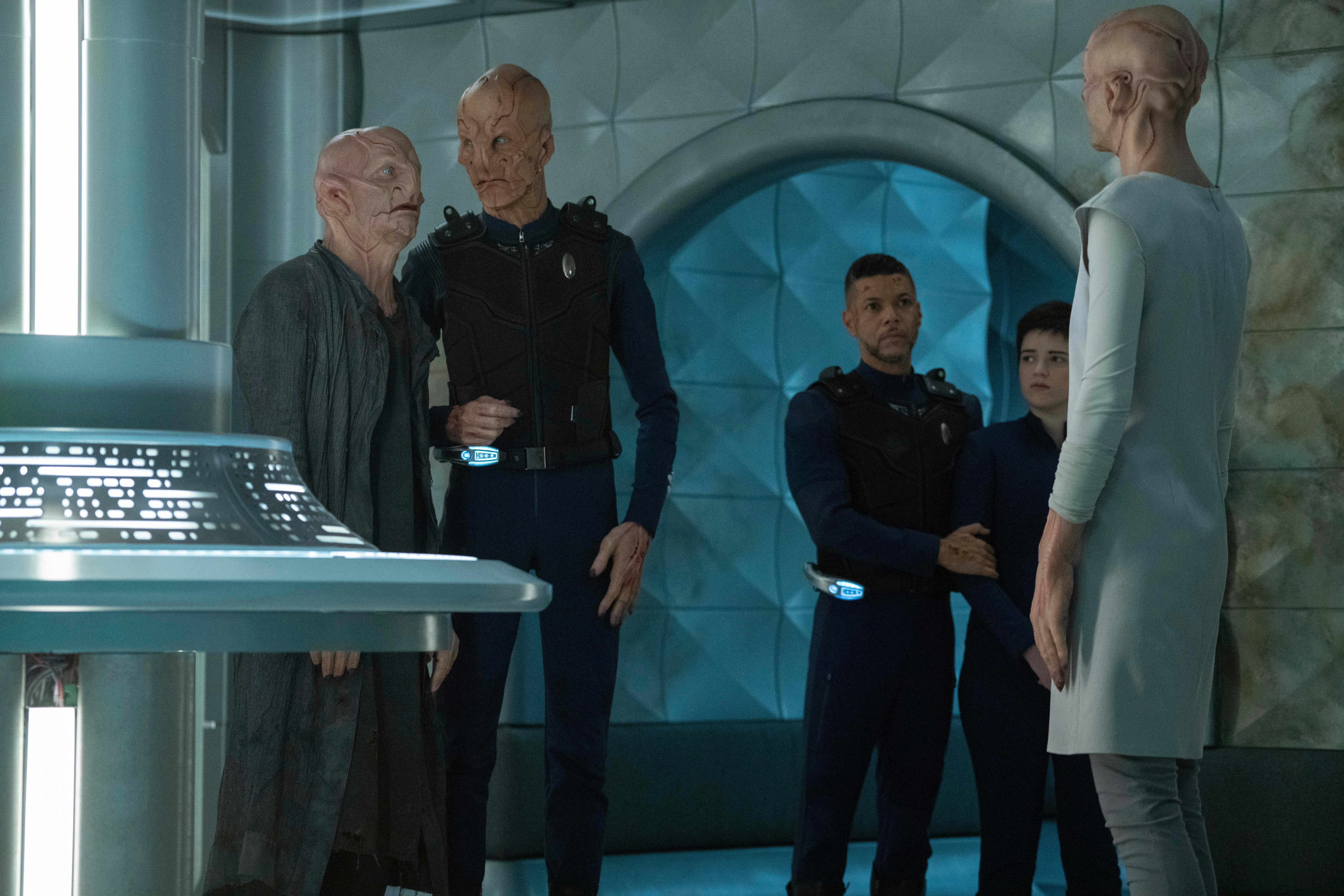Published Jan 13, 2021
The Science Behind Discovery's Burn
Star Trek: Discovery's science consultants take us behind the scenes to explain how The Burn was created.

StarTrek.com
In the third season of Star Trek: Discovery, the crew found themselves in the future and faced a new mystery: The Burn. All the crew knew initially was that, around 3069, any active dilithium was rendered inert, resulting in all active warp engines going critical. This restricted warp travel for over a hundred years and fractured the Federation. As the science consultants for Season 3, we helped develop the science behind both dilithium as well as the biology of an alien left in a unique environment that resulted in a galaxy-wide disaster.
First, we need to explore a little more about what dilithium is and how it works in a warp core. Dilithium has played a role in Star Trek from the very beginning. The key to remember is that dilithium is not fuel for the warp engines, but more a regulator. In order to build a warp bubble and “go to warp”, the ship needs an extremely high amount of energy to warp spacetime. In today’s physics, when matter and antimatter (like protons and antiprotons, or electrons and positrons) meet, they annihilate themselves and release energy. For Star Trek, this matter-antimatter reaction provides the energy needed to build a warp bubble. That’s where dilithium comes in: it regulates these reactions to keep them from going out of control or “going critical”.

StarTrek.com
Dilithium may be a fictional crystal from Star Trek, but in that world, it is composed of traditional baryonic matter (which is the stuff all the atoms and elements on the periodic table are made of) as well as complex subatomic particles which exist in subspace that allow the crystalline structure to form. We say “complex” in the sense that subspace, the region outside normal spacetime, can be thought of mathematically as living in a “complex plane”, similar to how imaginary numbers work. The crystalline structure of dilithium that is both in normal as well as subspace (and if you’d like, refers to the “di” part of dilithium) makes it a unique regulator for the amount of energy being released.
The Discovery crew eventually found a link between The Burn and a Kelpien alien named Su’Kal, discovered stranded on a dilithium planet. When Su’Kal screams, he sends out a sort of shockwave that carries through subspace. Su’Kal’s connection to subspace is unprecedented but has biological, and specifically genetic, roots from his exposure to radiation and chemicals (dilithium). Radiation and chemicals can cause DNA letter (A,C,G,T) changes called “mutations”, but genes can also be turned on/ off or turned up/ down in how much product (e.g., RNA) they make in response to radiation or chemicals. Such changes in amounts of gene product produced, called changes in “gene expression,” make sense because many of his cells across his body will respond similarly to external inputs, whereas if changes happened from new mutations, then each of his cells would get distinct mutations, and chaos could ensue. Part of the gene expression response happens through what is called (in real life as well as the show) “epigenetic modification”: the DNA letters are unchanged but may be tagged with a molecule to signal how much product to make. Su’Kal’s exposures therefore caused epigenetic changes which affected his body’s development.
A more specific hypothesis was proposed in the season finale by Dr. Culber: Su’Kal could be a “polyploid”. Rather than having one copy of every gene from mom and one copy from dad, polyploids have two or more from each of their parents. Polyploidy is very rare in mammals on Earth, but it is more common in frogs, fish, and plants, including cotton, potato, and (quadro)triticale. Polyploidy can be induced by radiation and can cause epigenetic changes. Additionally, polyploidy sometimes provides enhanced tolerance to stressful conditions, perhaps including radiation, thereby helping Su’Kal live in his radiation-flooded spaceship. In any case, epigenetic changes, whether through polyploidy or not, were induced by exposure to chemicals and radiation, and they cause Su’Kal to be physically different from other Kelpiens.

StarTrek.com
Linking the physics and biology from above, the complex subatomic particles allow dilithium to form a crystal structure with a particular resonant frequency. The abundance of these complex subatomic particles in dilithium-forming regions caused them to interact with physical changes in Su’Kal. We propose that the epigenetic changes (or his polyploid nature) caused Su’Kal’s vocal chords to develop in a manner where they resonate at the resonant frequency of the stable crystalline structure that ties dilithium from normal space to subspace. Because of this connection, his crisis permeated normal space as well as subspace. When Su’Kal cried out, he did so at the resonant frequency of the structure of dilithium, causing the subspace and normal-space portions of the crystal to dissociate. Because physics in subspace, the way it’s represented in Star Trek, is not limited to the speed of light, this associated shockwave occurred across a vast stretch of normal space almost instantaneously. While The Burn appeared to happen all at once, the fact that they were able to discern small differences and triangulate the location showed that not only did it occur at one point (the Verubin Nebula), but it had to have permeated subspace since it happened faster than the speed of light (the speed limit of our “normal” space). The dilithium that was actively being used destabilized and an exponential cascading effect of energy generation resulted in an instantaneous critical warp core explosion. Any dilithium that wasn’t being used by warp engines was still affected by this resonant frequency and still fractured, resulting in limitations to the availability and the extent to which it could be used.
The science of Star Trek has had a long legacy alongside creative storytelling. We are honored to have been asked to help the writers of Star Trek: Discovery tell this wonderful story by building a scientific background.
Dr. Erin Macdonald Explains Wormholes
Erin Macdonald (PhD, Astrophysics) (she/her) is an internationally recognized space science expert, writer, speaker, and consultant with a background in gravitational waves and general relativity. She currently lives in Los Angeles and is working as a writer as well as a science consultant for the Star Trek franchise.
Mohamed Noor (PhD, Ecology & Evolution) (he/him) is a Professor of Biology and the Dean of Natural Sciences at Duke University in Durham, NC. He conducts research and teaches in the areas of genetics and evolution. and he is contracted as a science consultant for the Star Trek franchise.
Star Trek: Discovery streams on Paramount+ in the United States, airs on Bell Media’s CTV Sci-Fi Channel and streams on Crave in Canada, and on Netflix in 190 countries.

